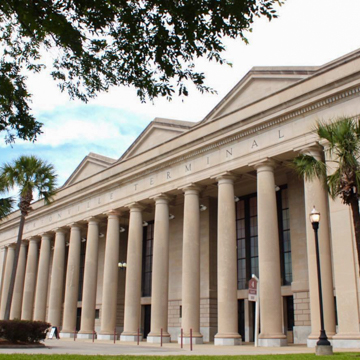You are here
Prime F. Osborn III Convention Center
At its inauguration in November 1919, Union Terminal was the largest railway structure in the South. Built on a site that had served as an important regional railway junction since the 1850s, Union Terminal replaced an earlier station, which was built by the Jacksonville Terminal Company to accommodate five railway companies whose facilities were scattered around the city’s periphery. Henry Flagler, the railway magnate who shaped cities from St. Augustine to Key West, had helped spearhead the initiative in 1893, and the new hub opened to rail traffic in 1895, two years before the completion of its enormous 150 x 900–foot train shed. By 1912, Flagler Depot was so busy that the city began the planning process for a monumental new building (one wing of Flagler’s station survives). The Neoclassical structure reflected the concern with national identity that had characterized architecture in the United States since the Columbian Exposition of 1893, and was fully consonant with the concerns of the City Beautiful movement.
In 1916, architect Kenneth Murchison won the commission through a competition launched the previous year. His design closely resembled the recently completed Pennsylvania Station in New York by McKim, Mead and White; and in a broader sense, Union Terminal’s coastal location at the regional terminus of several major rail lines represented a southern complement to the northern rail hub. Murchison, who was well acquainted with the Beaux-Arts classicism then in vogue, marked the entrance with a broad colonnade of fourteen unfluted Doric columns in antis, which opens onto a large plaza facing downtown Jacksonville (with which the station was connected by trolleys). The soaring, groin-vaulted ceiling of the ticketing hall and waiting room lend these spaces an appropriate level of grandeur, which is complemented by the eight thermal windows that provide clerestory lighting from above.
At an urban scale, the building played an important role by establishing an identifiable node at the edge of downtown Jacksonville, thereby giving regularity and structure to the urban fabric at a point where it had previously dissipated in the chaotic expanse of the rail lines and sidings. Furthermore, the development of the railway hub and the city’s expansion to the suburbs along the St. John’s River necessitated the construction of numerous elevated streets to cross the train tracks and the river’s tributaries. The Lee Street Viaduct, which passed in front of the newly completed Union Terminal in 1921, like the earlier Adams Street Viaduct, changed the topography of downtown Jacksonville and strengthened its connection to surrounding neighborhoods.
Murchison’s Union Terminal was the last in a succession of rail facilities built in the LaVilla district, one of six suburbs annexed by Jacksonville in 1887. The town had been home to a large African American community since the Civil War, when the area housed a Union garrison. During Reconstruction the population grew as former slaves moved to the city. In the early twentieth century, LaVilla remained a commercial hub and became a key stop for African American musicians on the Chitlin’ Circuit, but the train station was designed with segregated waiting areas, a legacy of Jim Crow–era legislation. After World War II the neighborhood, like many African American urban districts nationwide, was severely impacted by the construction of I-95.
In 1974, Amtrak relocated passenger trains to another facility, at which point Union Terminal was left unused and threatened with demolition. In 1982, a public-private partnership led by Prime F. Osborn III initiated efforts to transform the building into a convention center. Osborn died in 1986, the year the convention center was completed; it was named in his honor. In 2018, the Jacksonville Downtown Investment Authority requested proposals to replace the Osborn Convention Center, which currently houses 78,000 square feet of exhibit space, with a larger structure (complete with hotel and parking) on the site of the former county courthouse and city hall annex on East Bay Street.
References
Greer, Diane D., “Jacksonville Terminal Complex,” Duval County, Florida. National Register of Historic Places Inventory-Nomination Form, 1976. National Park Service, U.S. Department of the Interior, Washington, D.C.
Writing Credits
If SAH Archipedia has been useful to you, please consider supporting it.
SAH Archipedia tells the story of the United States through its buildings, landscapes, and cities. This freely available resource empowers the public with authoritative knowledge that deepens their understanding and appreciation of the built environment. But the Society of Architectural Historians, which created SAH Archipedia with University of Virginia Press, needs your support to maintain the high-caliber research, writing, photography, cartography, editing, design, and programming that make SAH Archipedia a trusted online resource available to all who value the history of place, heritage tourism, and learning.

